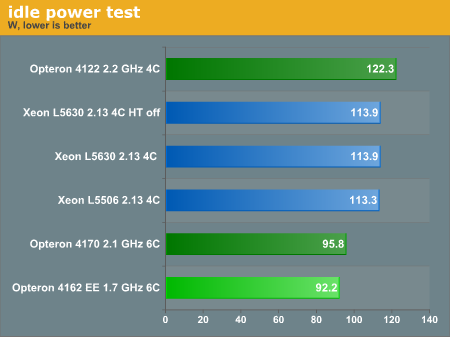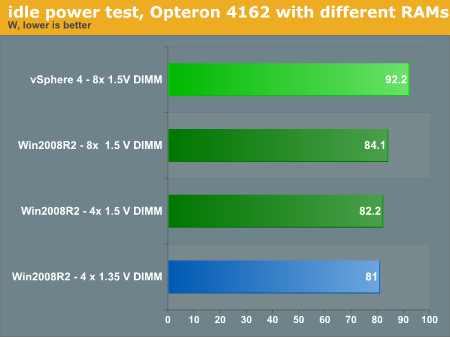Balancing Power, Price, and Performance in the Server CPU World
by Johan De Gelas on March 3, 2011 7:07 PM EST- Posted in
- IT Computing
- AMD
- Intel
- 1000W
- Xeon
- Opteron
- Cloud Computing
Idle Power Use
According to AMD, the key market for the low power "Lisbon" Opteron EE and HE is the cloud and web hosting space, where achieving the lowest power consumption possible is priority number one. So we measured the idle power draw running vSphere 4.1. The power policy selected was "Balanced".

Before we start analyzing the numbers, we must say that the Intel platform can probably go lower. It is possible to use a 450W PSU in this server, but we only had the 650W version available. This is an 80 Plus Silver certified PSU, so it should be at least 75% efficient at 10% load and 85% efficient at 20% load, and we're at around 15% load for this test. Although the idle numbers might be somewhat high for the Intel platform, our real-world power numbers on the next page shouldn't be off by more than a few watts, and those real-world numbers are the ones that count.
The AMD system came equipped with 16GB of low power DIMMs, but we did not use them for this test. The reason is that our vApusMark II takes 14GB per tile, and our standard test for dual socket systems is to use two tiles. Those two tiles need at least 28GB of RAM, plus some space for the ESX console and hypervisor (0.3 to 0.8 G RAM for the console + 0.5GB to 1GB for the vmkernel). We can show you what effect these low power DIMMs have at idle:

Even at idle, a hypervisor has more work to do than a supervisor OS like Windows 2008 R2. The result is a 10% higher power draw at idle. Each regular 1.5V DDR3 DIMM seems to take 0.5W at idle (2 Watt/4). If you replace four regular DDR3 DIMMs with four low power DIMMs at 1.35V, you can cut the RAM power draw in half. Low power DIMMs seem to save 0.3W per DIMM (1.2W / 4) at idle. So all in all, the RAM subsystems seems to draw little power at idle.
When the SQL server 2008 was running at 90% CPU load we measured a difference of 4.9W between four low power and 1.5V DDR-3 DIMMs. So low power DIMMs save you about 1.25W per 4 GB DIMM.










35 Comments
View All Comments
Zoomer - Friday, March 4, 2011 - link
Sure, obviously McAfee can magically make chips designed and produced before the acquisition more secure.duploxxx - Friday, March 4, 2011 - link
SAP:http://www.sap.com/ecosystem/customers/directories...
oracle:
Is turning all heads up side down, once they notice the volume shrink of x86 they will also drop it
http://www.oracle.com/us/corporate/analystreports/...
HangFire - Friday, March 4, 2011 - link
"...very inexpensive server, with a barebone price of only ~$1500 for two servers."Did you mean "sockets"?
Penti - Friday, March 4, 2011 - link
He means two servers. Or rather two nodes if you like. 2 pieces 2-way server.bobbozzo - Monday, March 7, 2011 - link
That server has 2 dual-socket motherboards in 1U; it's 2 servers in one, each with 2 CPU sockets.ERJ - Friday, March 4, 2011 - link
Home electric pricing is very different than rack pricing. Consider, for a good datacenter, you need UPS and power generators capable of matching every watt in use. You need pdu's. You have extra heat generation so you need additional cooling.For our colo space we pay somewhere in the range of $500 a month for a 30amp 120v circuit. Getting the best performance per watt is definitely part of our criteria.
Stuka87 - Friday, March 4, 2011 - link
I gotta thank you for the laugh. Never have I thought the word "craps" would make me laugh so much. I think it may be that you seem to use that word in every single post combined with one of the most narrow minded points of views I have seen on this site.All our craps are belong to you.
silverblue - Friday, March 4, 2011 - link
AMD must be good at the casino, what with all these "craps".I've long since filed sans2212 in the same category as SiliconDoc, under "has nothing to bring to the discussion whatsoever aside of (an initial period of) light entertainment for all readers (which rapidly becomes tedious)".
VJ - Saturday, March 5, 2011 - link
"You can get a slightly faster 1.8GHz version, the 4164 EE, but that chip costs more than twice as much ($698). As we are searching for low power and inexpensive CPUs, it didn't make the cut. The only disadvantage other than the lower clock speed is the lower clocked HT3 link at 2GT/s instead of 6.4GT/s."It's a bit of a weird paragraph since I was first thinking that you were suggesting the 4164 EE does 6.4GT/s but (for your sake) I can also interpret "instead of" in the final sentence to refer to the other AMD cpus you're testing here.
But it's still a deficient paragraph considering "the lower clocked HT3", since in reality, this resolves to an HT1 (for the 4162 EE).
It's like a car test mentioning a "less powerful V8 engine" when they're referring to a V6.
Gaat lekker, he?
oneoho - Tuesday, March 8, 2011 - link
great article, I was about to build some low power consumption / cooling requirement servers. This will help immensely.